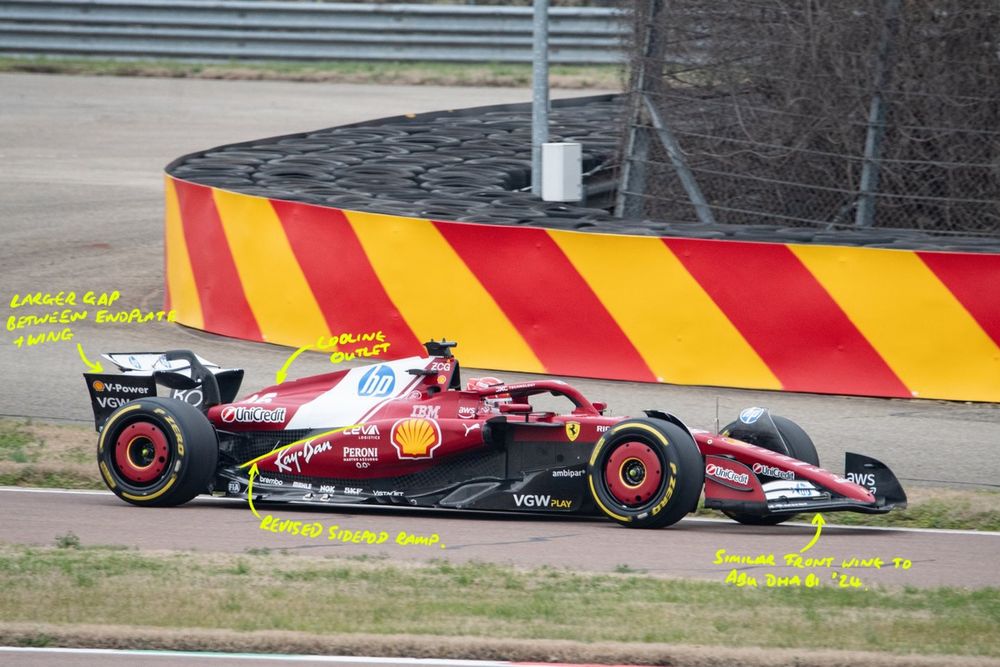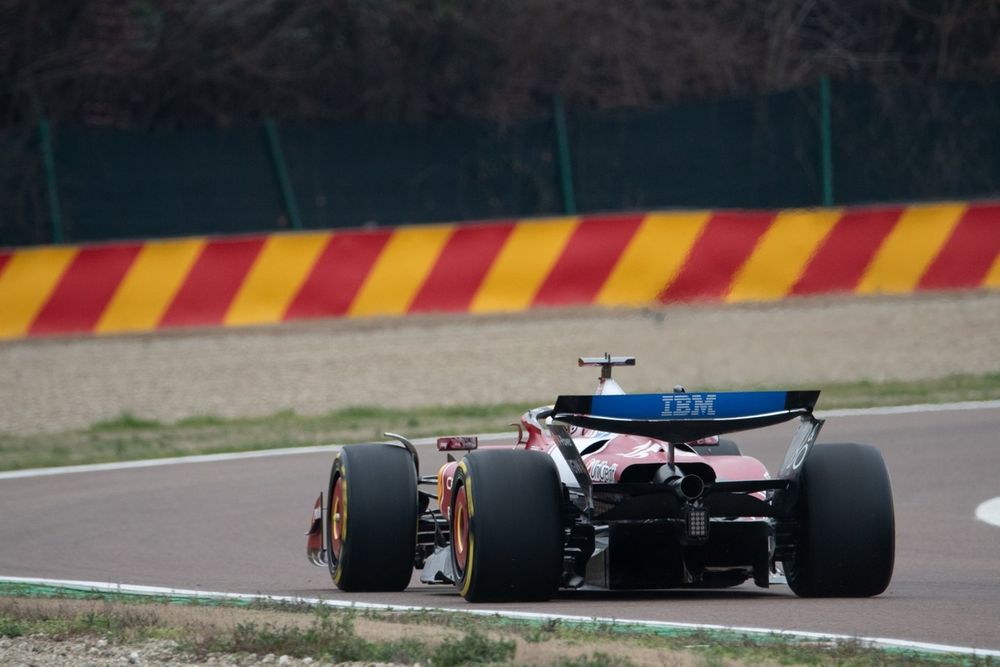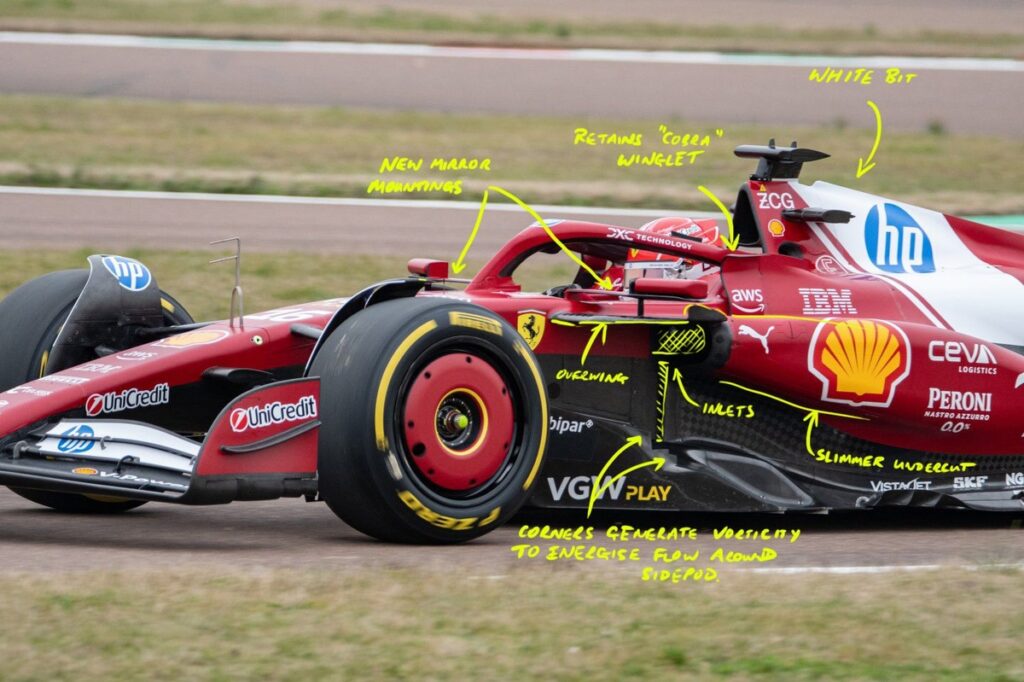London on Tuesday night, Fiorano by Wednesday morning; Ferrari’s key personnel either took a private plane directly from the F175 launch event at the O2 Arena (significantly likely), or hotfooted it to Stansted for the Ryanair flight to Bologna.
Actually, that eventuality might be a little less likely… can you imagine Lewis Hamilton, sitting uncomfortably on the blue leatherette seats, ordering a bag of Hula Hoops with a furtive eyebrow twitch at the £2.99 price tag? Sadly, no.
In any case, the proper SF-25 broke cover at Ferrari’s private test circuit on Wednesday morning, directly after its livery was revealed at the O2 on Tuesday. And, as was the case with its livery, there were generally few surprises – aside from the equivalent of one big white stripe down the engine cover.
Ferrari has made the switch to pull-rod suspension at the front for 2025, having stuck to the push-rod formula last season to largely great effect. This has prompted a reshuffle of the other suspension components to accommodate the change in direction here, particularly with a reangled upper wishbone that – conversely to the design direction taken by McLaren here – has had its rear leg raised upwards.
In response, Ferrari has a low wheel hub mounting for its pull-rod and, curiously, the lower wishbone stacked on top of the steering arms either side.
It’s an all-new front suspension package, and Ferrari must feel that its new layout can put the car in the right dynamic window for the variety of corners needed. The positioning of the wishbones lays out the platform when, for example, a team is trying to mitigate the amount of dive, but it also depends on the location of the centre of gravity. In switching to a pull-rod, Ferrari theoretically brings that down slightly as the rockers move to the bottom of the chassis.
Ferrari has switched to a pull-rod front suspension for 2025
Photo by: Davide Cavazza
In its press release, Ferrari stated that the “thinking behind this change in architecture was to clean up the airflow around the car, while also giving greater scope for further aero development, which had pretty much been exhausted with the previous iteration”.
Although this is a vague outline, the team nonetheless conceded that it had squeezed the last drop from its previous design and that Loic Serra’s new design direction, although evolutionary, was not afraid to ring the changes.
There are also visible changes to the SF-25’s sidepods, particularly around the inlet. Ferrari switched to the ‘overbite’ layout part-way through 2024 with an Imola update, and has stuck to the format albeit with a McLaren-like treatment to the inlet shape. What is seen is a conventional semi-elliptical inlet with an extruded upper overwing – as labelled in the images.
Although many of the changes appear subtle when viewed against its predecessor, Ferrari has billed its SF-25 as a top-to-tail evolution of the previous formula
This bends upwards at the tip to place the vortex shed from the exposed edge, which should help energise the airflow passing over the top of the sidepods. In this area, the small letterbox inlets remain along the edge of the chassis, which are intermittently theorised to be both part of the overall cooling system and an inlet to duct airflow elsewhere onto the car for aerodynamic purposes.
With the new inlet ‘overwing’, the mirrors have also received new mountings to contribute to the overall sidepod surface flow, and the outer floor fence has been equipped with a handful of exposed corners to further energise the airflow travelling around the sidepod undercut.
Teams have experimented with this over the past couple of years to make use of an area that is heavily restricted by the regulations, as the 2022-spec cars were intended as a sea-change from the overly complex bargeboard developments that pervaded in this area. This feeds refined sidepods, which are a lot smoother in form versus last year’s ‘pods.

The sidepod design is a key difference between the SF-24 and SF-25
Photo by: Davide Cavazza
Ferrari has retained the ‘cobra’ wings that sit either side of the cockpit, as it made use of a small area in the defined regulatory bounding boxes to help condition the airflow emerging from the front of the car and turning it around the engine cover. This aft area is in a similar layout to last season, albeit with fewer of the cooling louvres in the current spec.
That being said, these louvres are usually implemented with interchangeable panels that change from race to race, and 10-11C conditions in Italy don’t necessarily require the full-bore outlets to be used. The bodywork flares out at the back for heat rejection purposes, sitting above the rear-end channel that is opened by the continued use of a trough on top of the sidepods. There are also small openings along the centreline of the car at the rear of the engine cover, which can pull further hot air out of the car.
Interestingly, the rear wing shown at Fiorano has a distinct V-shaped trough in the middle – teams like to load the inboard section of the wing as this is the most effective area at generating downforce, and shallowing out the outboard parts is an effective way at trimming drag without too much of a downforce penalty. The upper wing element is also cut away from the mainplane, as has become a recent trend to ensure the wing tips can be used to generate vorticity to improve its effectiveness.
At the rear, Ferrari has continued to use a pull-rod suspension layout rather than make the leap to a push-rod. Moving the rockers and springs to the top side of the gearbox usually ensures that the team can make use of more space for the diffuser to provide the expansion of airflow, boosting downforce output, but Ferrari evidently feels that it does not necessarily need to reinvent the wheel to do so.
Although many of the changes appear subtle when viewed against its predecessor, Ferrari has billed its SF-25 as a top-to-tail evolution of the previous formula. The team developed well during the middle portion of the season, as its trajectory brought it into a constructors’ championship battle.
If it is to go one better, it needs to retain that strength throughout the season – and hope that the new Prancing Horse does not suffer similar mid-season development pitfalls.
Subscribe to Autosport Plus for more Formula 1 technical and in-depth analysis ahead of the 2025 season.

Will the SF-25 provide Ferrari its first F1 title of any kind since 2008?
Photo by: Davide Cavazza
In this article
Jake Boxall-Legge
Formula 1
Ferrari
Be the first to know and subscribe for real-time news email updates on these topics
Subscribe to news alerts
Read the full article here

